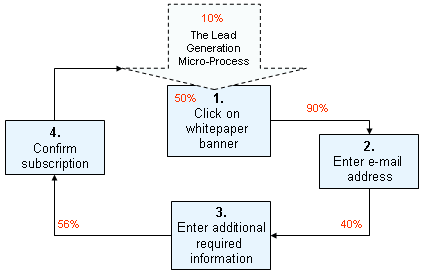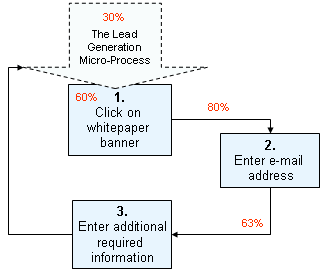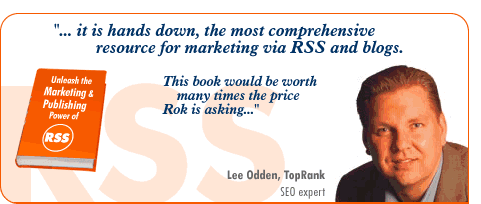| You are here: Home » Interactive Optimization and Analytics » Mastering Online Conversion » Defining Online Conversion: The Process Component Defining Online Conversion: The Process Component As far back as 2001, Bryan Eisenberg of GrokDotCom broke down conversion rate measurement and optimization by action type:
[BTW - check out Bryan's optimization e-books, which are an amazing resource for online optimization]
Bryan argued that each micro-action is a potential leak, where you might be losing macro-actions. By measuring the conversion only at the macro-level marketers are missing the real optimization potential of the website, since in order to optimize the macro-action conversion, you first need to optimize the micro-level conversions. Consequently it should be clear that measuring just the macro-action conversion rate won't take you far enough. You need to start measuring and optimizing on the micro-level. Now, to better understand this concept and to add a third dimension, let's take a quick look at a model I've been presenting at seminars in Europe for a few years now: Internet Processing. This is also the model I've tried to implement in any company I worked with, with varying success, since fully working under this model requires alot of measurement and optimization. But not to worry, you can also implement very basic variations of the model, which don't take that many resources. Quick Internet Processing OverviewInternet marketing is a process, not an activity. Hence, measurement and optimization cannot take place only on a single activity level, but should be done for your entire internet marketing process. I'd need alot more space and time to really explain all the aspects of this, so we'll just take a look at the simple version right now. Internet Processing consists of five distinct elements:
Consequently, Internet Processing demands that you measure your conversion and optimize it on each of these five levels. Today we'll just take a look at the 3 parts that are most important for conversion rate measurement, and leave the details of the model for a later time. Macro-ProcessImagine the macro-process as a sequence of all of the big steps you need to complete with a user to reach your ultimate goal, converting him from one user status to another. The macro-process will be different for every company, based on your internet marketing strategy. The macro-process needs to support the strategy. Let's take a look at a quick example:
The image represents an overall macro-process, with the boxes representing the micro-processes within the macro-process, and the lines showing the current status of the user. When measuring the macro-process conversion, you are measuring your conversion of getting the user from one stage to another, as displayed here: For example, the 10% conversion rate from first-time visitor to e-zine subscriber tells you that 10% of your first time visitors are converting into e-zine subscribers. And then, 10% of your e-zine subscribers are converting into loyal subscribers. What happens if we add some numbers?
Micro-ProcessNow, to understand the power of this model for optimization, consider what happens if you increase your overall conversion from first-time visitors acquired to e-zine subscribers acquired, keeping all the other numbers the same. Let's say that you manage to increase this conversion to 30%:
Instead of 1,000,000 e-zine subscribers you now have 3,000,000, and this eventually converts to 30,000 customers as opposed to 10,000 customers ... just by optimizing your e-zine subscription process. It needs to be admitted that this demonstration is taking a much to simplistic view of the conversion process, but it should be enough right now to show you the power of taking an overall look at your internet marketing process. But, in order to get this kind of increase, you actually need to optimize the lead generation micro-process, which in this case is also 10% when we start with it. So, we need to take a look at the lead generation micro-process:
What does this process tell us?
To optimize this micro-process to achieve the increase of the e-zine subscriber/first-time visitor conversion rate to 30%, we have two optimization routes, and one of them takes place on the overall micro-process level. The simplest thing to do --> remove the confirmation micro-action:
By removing the confirmation micro-action, the total conversion rate for the lead generation micro-processes jumped to 18%. This is optimization on the micro-process level. Micro-ActionThe other optimization route is optimizing the actual micro-actions that form the micro-process, for example optimizing the whitepaper banner in such a way that a higher % of first-time visitors take notice of it and click on it. At the same time, we optimize the field for entering additional information, perhaps removing some required fields to make things easier for our visitors.
This was optimization on the micro-action level. Again, all of these examples were fairly simplistic and did not take the entire complexity of the issue into account, but they should be enough to demonstrate the Internet Processing model, which we will cover in greater detail in the weeks and months to come. Comments
This site give's a clear information to us,although here i am liking u a relevant site to get more details.
Awj6jg A number of universities have awarded her honorary degrees, and she earned a prestigious job on the staff of Detroit congressman John Conyers. In 1988 Roxanne Brown noted: "Thirty-two years after she attracted international attention for sparking the Montgomery Bus Boycott, Mrs. Parks's ardent devotion to human rights still burns brightly, like a well-tended torch that ignites her spirit and calls her to service whenever she is needed." 1. In Gods Hands 4:08 5.10 Mb 2. Say it Right (Rauhofer remix part 1) 8:34 9.10 Mb 3. Maneater (Rauhofer mix Show) 5:34 1. In Gods Hands 4:08 5.10 Mb 2. Say it Right (Rauhofer remix part 1) 8:34 9.10 Mb 3. Maneater (Rauhofer mix Show) 5:34 Hello! Good Site! Thanks you! bqdpottffq
|
Internet Optimization Blog Interactive Optimization and Analytics Blog focuses on practical strategies and tactics on optimizing your internative marketing mix, from traditional direct to online, including channel integration, e-commerce and processes. Edited by Rok Hrastnik RSS Feed for this Blog: Unleash the Marketing & Publishing Power of RSS
The e-book that is defining RSS marketing.
|








